-

新人教版高中英语必修3Unit 2 Morals and Virtues教学设计三
The joke set her crying.这个玩笑使她哭起来。Step 5 ReadingActivity 31. Students read the small text in activity 3. The teacher provides several small questions to check whether students understand the content of the text and the ideographic function of the -ing form in the text.*Where are those people?*Why did Dr Bethune come to China?*How did he help the Chinese people during the war?*What did Chairman Mao Zedong say about him?2. Ss try to rewrite some sentences using the -ing form. Then check the answers. When checking the answers, the teacher can ask different students to read the rewritten sentences and give comments.Answers:1. he became very interested in medicine, deciding to become a doctor.2. …after hearing that many people were dying in the war.3. Helping to organise hospitals, he taught doctors and nurses, and showed people how to give first aid./ He helped to organise hospitals, teaching doctors and nurses, and showing people how to give first aid.4. …praising Dr Bethune as a hero to be remembered in China.Step 6 PracticeActivity 4Students complete grammar activities 2 and 3 on page 69 of the workbook.Step 6 Homework1. Understand and master the functions and usage of the -ing form;2. Finish the other exercises in Using structures.1、通过本节内容学习,学生是否理解和掌握动词-ing形式作宾语补足语语和状语语的功能和意义;2、通过本节内容学习,学生能否正确使用动词-ing形式描述人物的行为、动作及其经历;3、通过本节内容学习,学生能否独立完成练习册和导学案中的相关练习。

新人教版高中英语必修3Unit 2 Morals and Virtues教学设计四
3.Teachers ask different groups to report the answers to the questions and ask them to try different sentence patterns.The teacher added some sentence patterns for students to refer to when writing.Step 4 Writing taskActivity 51.Write the first draft.Students first review the evaluation criteria in activity 5, and then independently complete the draft according to the outline of activity 4, the answers to the questions listed in the group discussion and report, and the reference sentence pattern.2.Change partners.The teacher guides the students to evaluate their partner's composition according to the checklist of activity 5 and proposes Suggestions for modification.3.Finalize the draft.Based on the peer evaluation, students revise their own compositions and determine the final draft.Finally, through group recommendation, the teacher selects excellent compositions for projection display or reading aloud in class, and gives comments and Suggestions.Step 5 Showing writingActivity 5T call some Ss to share their writing.Step 6 Homework1. Read the passage in this section to better understand the passage.2. Carefully understand the hierarchical structure of the article, and deeply understand the plot of the story according to the causes, process and results;3. Independently complete the relevant exercises in the guide plan.1、通过本节内容学习,学生是否理解和掌握阅读文本中的新词汇的意义与用法;2、通过本节内容学习,学生能否通过人物言行的对比分析道德故事的深层内涵;3、通过本节内容学习,学生能否根据故事的起因、经过和结果来深入理解故事的情节,从而了解文章的层次结构;4、结合现实生活案例发表自己的见解和看法,写一篇观点明确、层次分明的故事评论。

新人教版高中英语必修3Unit 2 Morals and virtues教学设计一
(2) students are divided into groups according to the requirements of activity 3. Each student shares a story of personal experience or hearing-witnessing kindness, and then selects the most touching story in the group and shares it with the whole class. Before the students share the story, the teacher can instruct them to use the words and sentence patterns in the box to express. For example, the words in the box can be classified:Time order: first of all, then, after that, later, finally logical relationship :so, however, although, butTeachers can also appropriately add some transitional language to enrich students' expression:Afterwards, afterwards, at last, in the end, eventuallySpatial order: next to, far from, on the left, in front ofOtherwise, nevertheless, as a result, therefore, furthermore, in addition, as well asSummary: in a word, in short, on the whole, to sum up, in briefStep 8 Homework1. Understand the definition of "moral dilemma" and establish a correct moral view;2. Accumulate vocabulary about attitudes and emotions in listening texts and use them to express your own views;3. Complete relevant exercises in the guide plan.1、通过本节内容学习,学生能否理解理解“道德困境”的定义;2、通过本节内容学习,学生能否通过说话人所表达的内容、说话的语气、语调等来判断其态度和情绪;3、通过本节内容学习,学生能否针对具体的道德困境发表自己的看法和见解,能否掌握听力理训练中的听力策略。

新人教版高中英语必修3Unit 3 Diverse Cultures教学设计三
The price is the same as(the price was)before the war.价格与战前相同。(4)定语从句中的“关系代词+助动词be”可以省略。The ticket(that/which was)booked by his sister has been sent to him.他妹妹订的那张票已送到了他那里。Step 5 PracticeActivity 3(1) Guide students to complete the four activities in the Using Structures part of exercise book, in which activities 1 and 2 focus on ellipsis in dialogue answers, activity 3 focus on signs and headlines, two typical situations where ellipsis is used, and activity 4 focus on ellipsis in diary, an informal style.(2) Combine the examples in the above activities, ask students to summarize the omitted situations in groups, and make their own summary into a poster, and post it on the class wall after class to share with the class.(This step should give full play to the subjectivity of students, and teachers should encourage students to conclude different ellipsis phenomena according to their own understanding, they can conclude according to the different parts omitted in the sentence.)Step 6 Homework1. Understand and master the usages of ellipsis;2. Finish the other exercises in Using structures of Workbook.1、通过本节内容学习,学生是否理解和掌握省略的用法;2、通过本节内容学习,学生能否根据上下文语境或情景恢复句子中省略的成分,体会使用省略的效果;3、通过本节内容学习,学生能否独立完成练习册和导学案中的相关练习。

新人教版高中英语必修3Unit 3 Diverse Cultures教学设计二
(2)Consolidate key vocabulary.Ask the students to complete the exercises of activity 6 by themselves. Then ask them to check the answers with their partners.(The first language:Damage of the 1906 San Francisco earthquake and fire.A second language: Yunnan - one of the most diverse provinces in China).Step 5 Language points1. The teacher asks the students to read the text carefully, find out the more words and long and difficult sentences in the text and draw lines, understand the use of vocabulary, and analyze the structure of long and difficult sentences.2. The teacher explains and summarizes the usage of core vocabulary and asks the students to take notes.3. The teacher analyzes and explains the long and difficult sentences that the students don't understand, so that the students can understand them better.Step 6 Homework1. Read the text again, in-depth understanding of the text;2. Master the use of core vocabulary and understand the long and difficult sentences.3. Complete relevant exercises in the guide plan.1、通过本节内容学习,学生是否理解和掌握阅读文本中的新词汇的意义与用法;2、通过本节内容学习,学生能否结合文本特点了解文章的结构和作者的写作逻辑;3、通过本节内容学习,学生能否了解旧金山的城市风貌、文化特色,以及加利福尼亚州的历史,体会多元文化对美国的影响。

新人教版高中英语必修3Unit 3 Diverse Cultures教学设计四
该板块的活动主题是“介绍一个有显著文化特征的地方”( Describe a place with distinctive cultural identity)。该板块通过介绍中国城继续聚焦中国文化。本单元主题图呈现的是旧金山中国城的典型景象, Reading and Thinking部分也提到中国城,为该板块作铺垫。介绍中国城的目的主要是体现中国文化与美国多元文化的关系,它是美国多元文化的重要组成部分。中国城也是海外华人的精神家园和传播中国文化的重要窗口,外国人在中国城能近距离体验中国文化。1. Read the text to understand the cultural characteristics of Chinatown in San Francisco and the relationship between Chinese culture and American multiculturalism;2. Through reading, learn to comb the main information of the article, understand the author's writing purpose and writing characteristics;3. Learn to give a comprehensive, accurate, and organized description of the city or town you live in;Learn to revise and evaluate your writing.Importance:1. Guide the students to read the introduction of Chinatown in San Francisco and grasp its writing characteristics;2. Guide students to introduce their city or town in a comprehensive, accurate and organized way;3. Learn to comb the main information of the article, understand the author's writing purpose, and master the core vocabulary.

新人教版高中英语必修3Unit 3 Diverse Cultures教学设计一
Activity 81.Grasp the main idea of the listening.Listen to the tape and answer the following questions:Who are the two speakers in the listening? What is their relationship?What is the main idea of the first part of the listening? How about the second part?2.Complete the passage.Ask the students to quickly review the summaries of the two listening materials in activity 2. Then play the recording for the second time.Ask them to complete the passage and fill in the blanks.3.Play the recording again and ask the students to use the structure diagram to comb the information structure in the listening.(While listening, take notes. Capture key information quickly and accurately.)Step 8 Talking Activity 91.Focus on the listening text.Listen to the students and listen to the tape. Let them understand the attitudes of Wu Yue and Justin in the conversation.How does Wu Yue feel about Chinese minority cultures?What does Justin think of the Miao and Dong cultures?How do you know that?2.learn functional items that express concerns.Ask students to focus on the expressions listed in activity. 3.And try to analyze the meaning they convey, including praise (Super!).Agree (Exactly!)"(You're kidding.!)Tell me more about it. Tell me more about it.For example, "Yeah Sure." "Definitely!" "Certainly!" "No kidding!" "No wonder!" and so on.4.Ask the students to have conversations in small groups, acting as Jsim and his friends.Justin shares his travels in Guizhou with friends and his thoughts;Justin's friends should give appropriate feedback, express their interest in relevant information, and ask for information when necessary.In order to enrich the dialogue, teachers can expand and supplement the introduction of Miao, dong, Lusheng and Dong Dage.After the group practice, the teacher can choose several groups of students to show, and let the rest of the students listen carefully, after listening to the best performance of the group, and give at least two reasons.
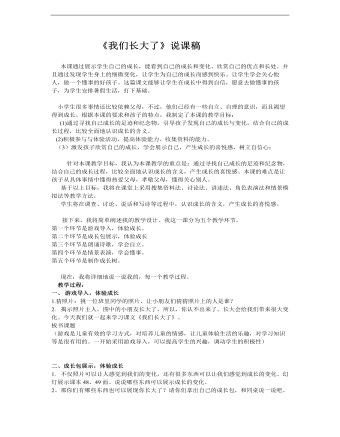
小学科学鄂教版四年级上册《我们长大了》说课稿
小学生很多事情还比较依赖父母,不过,他们已经有一些自立、自理的意识,而且渴望得到成长。根据本课的要求和孩子的特点,我制定了本课的教学目标: (1)通过寻找自己成长的足迹和纪念物,引导孩子发现自己的成长与变化,结合自己的成长过程,比较全面地认识成长的含义。 (2)积极参与与体验活动,提高体验能力、收集资料的能力。 (3)激发孩子欣赏自己的成长,学会展示自己,产生成长的喜悦感,树立自信心; 针对本课教学目标,我认为本课教学的重点是:通过寻找自己成长的足迹和纪念物,结合自己的成长过程,比较全面地认识成长的含义,产生成长的喜悦感。本课的难点是让孩子从具体事情中懂得热爱父母,孝敬父母,懂得关心别人。 基于以上目标,我将在课堂上采用搜集资料法、讨论法、讲述法、角色表演法和情景模拟法等教学方法。
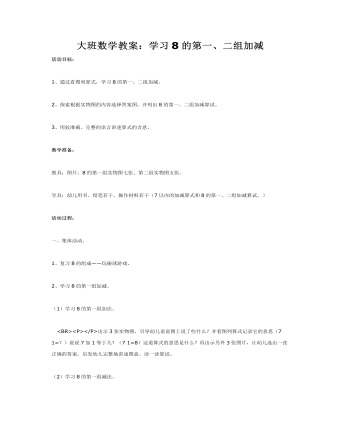
大班数学教案:学习8的第一、二组加减(江苏)
2、探索根据实物图的内容选择答案图,并列出8的第一、二组加减算试。3、用较准确、完整的语言讲述算式的含意。教学准备:教具:图片:8的第一组实物图七张、第二组实物图五张。学具:幼儿用书、铅笔若干。操作材料若干(7以内的加减算式和8的第一、二组加减算试。)活动过程:一、集体活动。1、复习8的组成——玩碰球游戏。2、学习8的第一组加减。
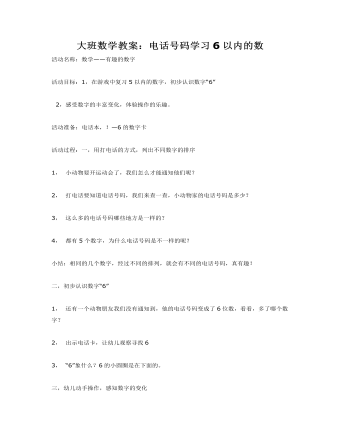
大班数学教案:电话号码学习6以内的数
活动准备:电话本,!—6的数字卡活动过程:一,用打电话的方式,列出不同数字的排序1, 小动物要开运动会了,我们怎么才能通知他们呢?2, 打电话要知道电话号码,我们来查一查,小动物家的电话号码是多少?3, 这么多的电话号码哪些地方是一样的?4, 都有5个数字,为什么电话号码是不一样的呢?小结:相同的几个数字,经过不同的排列,就会有不同的电话号码,真有趣!
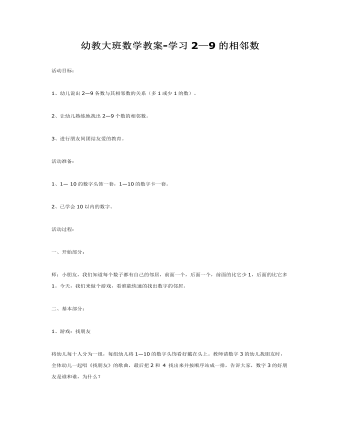
幼教大班数学教案-学习2—9的相邻数
2、让幼儿熟练地找出2—9个数的相邻数。3、进行朋友间团结友爱的教育。活动准备:1、1— 10的数字头饰一套,1—10的数字卡一套。2、已学会10以内的数字。活动过程:一、开始部分:师:小朋友,我们知道每个数子都有自己的邻居,前面一个,后面一个,前面的比它少1,后面的比它多1。今天,我们来做个游戏,看谁能快速的找出数字的邻居。
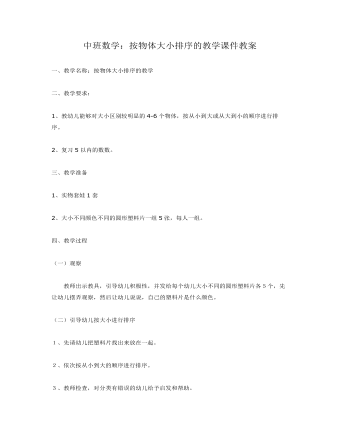
中班数学:按物体大小排序的教学课件教案
二、教学要求:1、教幼儿能够对大小区别较明显的4-6个物体,按从小到大或从大到小的顺序进行排序。2、复习5以内的数数。三、教学准备1、实物套娃1套2、大小不同颜色不同的圆形塑料片一组5张,每人一组。
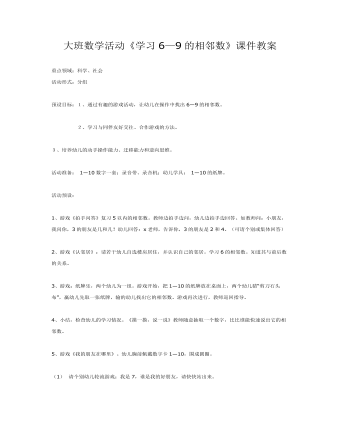
大班数学活动《学习6—9的相邻数》课件教案
2、学习与同伴友好交往、合作游戏的方法。3、培养幼儿的动手操作能力、迁移能力和逆向思维。活动准备: 1—10数字一套;录音带、录音机;幼儿学具: 1—10的纸牌。活动预设:1、游戏《拍手问答》复习5以内的相邻数。教师边拍手边问,幼儿边拍手边回答。如教师问:小朋友,我问你,3的朋友是几和几?幼儿回答:x老师,告诉你,3的朋友是2和4。(可请个别或集体回答)2、游戏《认邻居》:请若干幼儿自选楼房居住,并认识自己的邻居。学习6的相邻数。知道其与前后数的关系。3、游戏:纸牌乐,两个幼儿为一组。游戏开始,把1—10的纸牌放在桌面上,两个幼儿猜“剪刀石头布”,赢幼儿先取一张纸牌,输的幼儿找出它的相邻数。游戏再次进行,教师巡回指导。
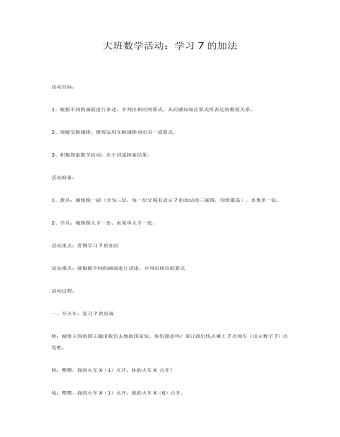
大班数学活动:学习7的加法课件教案
2、理解交换规律,懂得运用互换规律列出另一道算式。3、积极探索数学活动,乐于讲述探索结果。活动准备:1、教具:城堡图一副(分为三层,每一层分别有表示7的加法的三副图,用纸覆盖)、水果单一张。2、学具:城堡图人手一份、水果单人手一张。活动重点:看图学习7的加法活动难点:能根据不同的画面进行讲述,并列出相应的算式活动过程:一、开火车:复习7的组成师:城堡王国的国王邀请我们去他的国家玩,你们愿意吗?那让我们快点乘上7次列车(出示数字7)出发吧。师:嘿嘿,我的火车X(1)点开,你的火车X 点开?幼:嘿嘿,我的火车X(1)点开,我的火车X(6)点开。
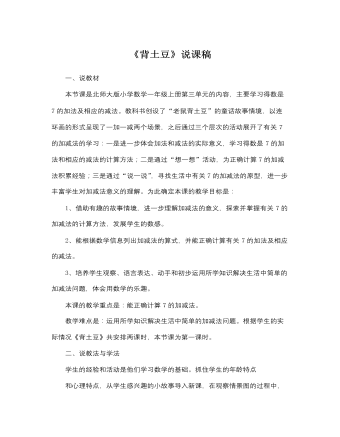
北师大版小学数学一年级上册《背土豆》说课稿
本课的教学重点是:能正确计算7的加减法。教学难点是:运用所学知识解决生活中简单的加减法问题。根据学生的实际情况《背土豆》共安排两课时,本节课为第一课时。二、说教法与学法学生的经验和活动是他们学习数学的基础。抓住学生的年龄特点和心理特点,从学生感兴趣的小故事导入新课,在观察情景图的过程中,既培养学生的观察能力和语言表达能力,又激发了学生学习数学的兴趣。同时充分利用了学具和多媒体教学手段,调动学生多种感官参与学习。整节课以故事为主线,把教学内容串了起来,尽可能地激发学生的求知欲望。教学过程紧扣教材,根据学生的实际适时引导。有效的学习就是激励学生动手实践、自主探索与合作交流。本课教学中,我尽可能地引导学生自主提问,自己解决问题,让学生在探索、操作、交流获取新知。
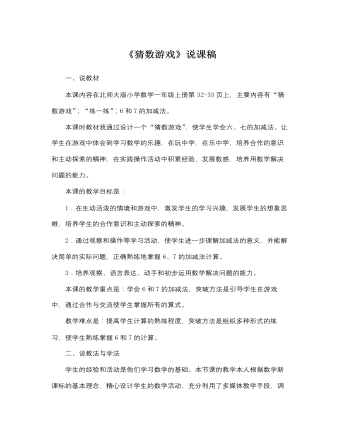
北师大版小学数学一年级上册《猜数游戏》说课稿
二、说教法与学法学生的经验和活动是他们学习数学的基础。本节课的教学本人根据数学新课标的基本理念,精心设计学生的数学活动,充分利用了多媒体教学手段,调动学生多种感官参与学习。让学生在实际中运用所学知识,体现了数学来源于生活,生活离不开数学。整节课以游戏、活动为主线,把教学内容清晰有趣地串了起来,设计了新颖的情景教学和动画故事,尽可能的激发学生的求知欲望。教学过程紧扣教材,层层递进,环环相扣,教师能根据学生的实际适时的引导,使整节课能顺利完成教学任务。有效的学习就是激励学生动手实践、自主探索与合作交流。本课教学中,本人就注意实践操作与游戏活动有机地结合,让学生在玩、交流中思考,在思考中探索,获取新知。三、说教学过程本节课的教学我主要设计了六个环节:提问导入、猜数游戏、实际应用、回顾总结、课堂作业。
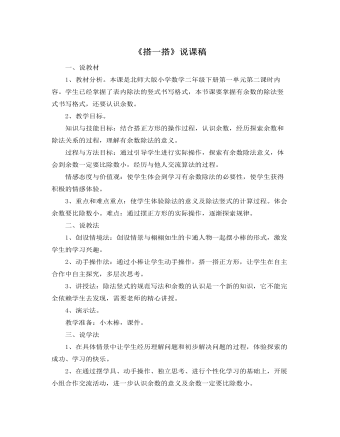
北师大版小学数学二年级下册《搭一搭》说课稿
(1)课件显示搭正方形的画面以及问题“4根小棒搭一个正方形,13根小棒可以搭多少个正方形,还剩几根?”。(2)组织小组讨论:有13根小棒,能搭几个正方形?请每个同学利用学具摆一摆,再依据上节课学习的除法算式,小组内讨论用竖式怎样表示。【设计意图:通过摆小棒搭正方形和自主探究等开发学生思维,促进学生多层次思考,培养孩子良好的思维方式,推动学生积极思考,逐步开阔学生解决问题的思路,培养学生横向思维能力。】(3)进行全班交流。指名回答;引导学生探究竖式各数表示的意思及单位名称的写法,并进一步认识余数。课件显示搭小棒的过程及横式和竖式:13÷4=3(个)……1(根)答:可以搭3个正方形,还剩1根。引导学生认识竖式中:“13”表示把13根小棒拿去分,“4”表示摆一个正方形需要4根小棒,“3”表示可以摆3个正方形(强调单位“个”),“12”表示3个正方形共12根(4×3=12)。“1”表示摆了3个后还剩下1根(强调单位:“根”),说明“1”是这个竖式的余数,这1根不能再继续往下分了。
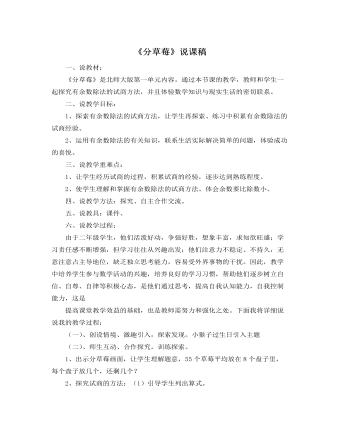
北师大版小学数学二年级下册《分草莓》说课稿
二、说教学目标:1、探索有余数除法的试商方法,让学生再探索、练习中积累有余数除法的试商经验。2、运用有余数除法的有关知识,联系生活实际解决简单的问题,体验成功的喜悦。三、说教学重难点:1、让学生经历试商的过程,积累试商的经验,逐步达到熟练程度。2、使学生理解和掌握有余数除法的试商方法。体会余数要比除数小。四、说教学方法:探究、自主合作交流。五、说教具:课件、六、说教学过程:由于二年级学生,他们活泼好动,争强好胜,想象丰富,求知欲旺盛;学习责任感不断增强,但学习往往从兴趣出发;他们注意力不稳定、不持久,无意注意占主导地位,缺乏独立思考能力,容易受外界事物的干扰。因此,教学中培养学生参与数学活动的兴趣,培养良好的学习习惯,帮助他们逐步树立自信、自尊、自律等积极心态,是他们通过思考,提高自我认知能力,自我控制能力,这是提高课堂教学效益的基础,也是教师需努力和强化之处。下面我将详细说说我的教学过程:
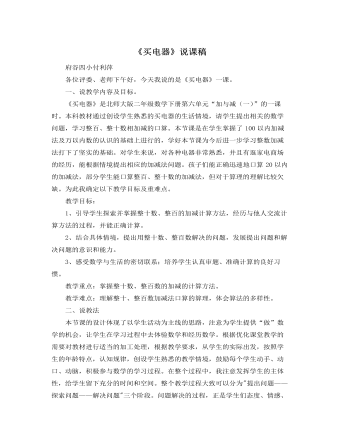
北师大版小学数学二年级下册《买电器》说课稿
一、说教学内容及目标。《买电器》是北师大版二年级数学下册第六单元“加与减(一)”的一课时。本科教材通过创设学生熟悉的买电器的生活情境,请学生提出相关的数学问题,学习整百、整十数相加减的口算。本节课是在学生掌握了100以内加减法及万以内数的认识的基础上进行的,学好本节课为今后进一步学习整数加减法打下了坚实的基础。对学生来说,对各种电器非常熟悉,并且有逛家电商场的经历,能根据情境提出相应的加减法问题。孩子们能正确迅速地口算20以内的加减法,部分学生能口算整百、整十数的加减法,但对于算理的理解比较欠缺。为此我确定以下教学目标及重难点。教学目标:1、引导学生探索并掌握整十数、整百的加减计算方法,经历与他人交流计算方法的过程,并能正确计算。2、结合具体情境,提出用整十数、整百数解决的问题,发展提出问题和解决问题的意识和能力。
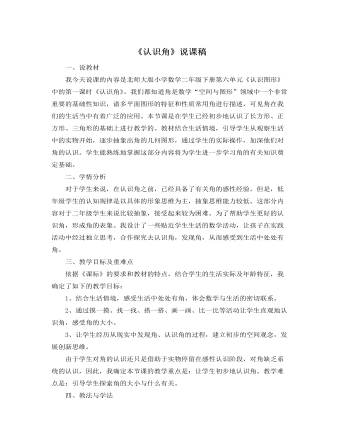
北师大版小学数学二年级下册《认识角》说课稿
二、学情分析对于学生来说,在认识角之前,已经具备了有关角的感性经验。但是,低年级学生的认知规律是以具体的形象思维为主,抽象思维能力较低。这部分内容对于二年级学生来说比较抽象,接受起来较为困难。为了帮助学生更好的认识角,形成角的表象。我设计了一些贴近学生生活的数学活动,让孩子在实践活动中经过独立思考,合作探究去认识角,发现角,从而感受到生活中处处有角。三、教学目标及重难点依据《课标》的要求和教材的特点,结合学生的生活实际及年龄特征,我确定了如下的教学目标:1、结合生活情境,感受生活中处处有角,体会数学与生活的密切联系。2、通过摸一摸、找一找、搭一搭、画一画、比一比等活动让学生直观地认识角,感受角的大小。